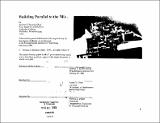| dc.contributor.advisor | Renee Y. Chow. | en_US |
| dc.contributor.author | Boutros-Ghali, Perihan S. (Perihan Safeya) | en_US |
| dc.contributor.other | Massachusetts Institute of Technology. Dept. of Architecture. | en_US |
| dc.date.accessioned | 2011-07-18T13:54:27Z | |
| dc.date.available | 2011-07-18T13:54:27Z | |
| dc.date.copyright | 1990 | en_US |
| dc.date.issued | 1990 | en_US |
| dc.identifier.uri | http://hdl.handle.net/1721.1/64848 | |
| dc.description | Thesis (M. Arch.)--Massachusetts Institute of Technology, Dept. of Architecture, 1990. | en_US |
| dc.description | Includes bibliographical references (p. 71-76). | en_US |
| dc.description.abstract | This thesis will be an exploration of the issues of building in the Egyptian landscape. Human inhabitation of the Egyptian landscape has for many thousands of years been centred within the zone of the Nile River valley. In the past, this ribbon of arable land was able to support the food requirements of the population and produce a surplus of agricultural products for export. Today, Egypt's population of 54 million exists on 30,000 km.2 of habitable area concentrated in the Nile River valley out of a total area of approximately one million sq. km. The population is growing rapidly, and in fact, in areas of urban growth, illegal building is occurring on scarce arable land. In the 1970's, in an effort to divert such growth, strategies for newtowns situated in the interior of the desert were planned, and several were executed. However, I propose to put forward an attitude of growth that would run North-South, to build on the desert edge, above and parallel to the Nile valley where existing arable land meets desert and to extend arable zones into the desert. In the course of this project, I will examine a) -as preface -the Nile valley in context to the historic development of an irrigation society: trace the domestication of the Nile. b) -as observation of the desert - formal and spatial inhabitations in the regional landscape and from other similar landscapes c) - as projection of the possible-an agricultural research centre which by its raison d'etre will maintain a distinction of what landscape is built and what remains free for new cultivation. The building will include work spaces, labs, sleeping and living facilities for both permanent and short term staff. | en_US |
| dc.description.statementofresponsibility | by Perihan S. Boutros-Ghali. | en_US |
| dc.format.extent | 77 p. | en_US |
| dc.language.iso | eng | en_US |
| dc.publisher | Massachusetts Institute of Technology | en_US |
| dc.rights | M.I.T. theses are protected by
copyright. They may be viewed from this source for any purpose, but
reproduction or distribution in any format is prohibited without written
permission. See provided URL for inquiries about permission. | en_US |
| dc.rights.uri | http://dspace.mit.edu/handle/1721.1/7582 | en_US |
| dc.subject | Architecture. | en_US |
| dc.title | Building parallel to the Nile | en_US |
| dc.type | Thesis | en_US |
| dc.description.degree | M.Arch. | en_US |
| dc.contributor.department | Massachusetts Institute of Technology. Department of Architecture | |
| dc.identifier.oclc | 23165962 | en_US |
